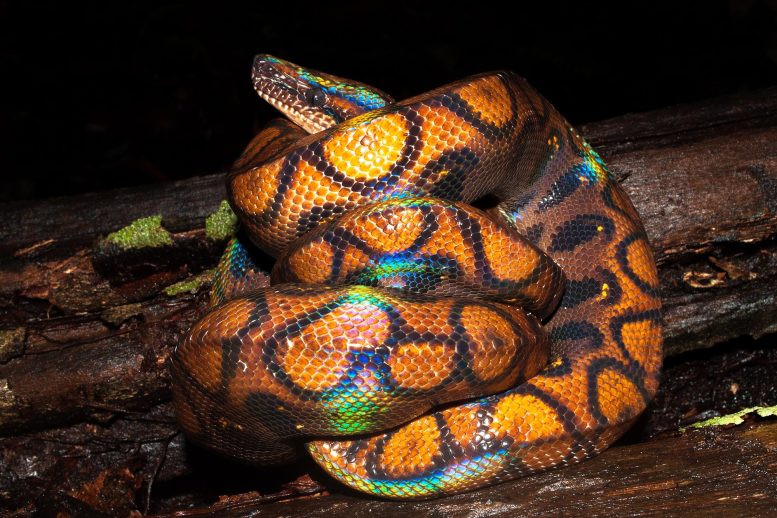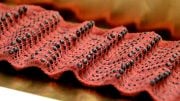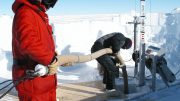
Rainbow Boa
Boa constrictors breathe with different sections of rib cage when constricting prey and digesting dinner.
The later stages of pregnancy can make life difficult as the fetus presses against the diaphragm making it hard to breathe. But snakes that constrict their victims before swallowing them whole have to overcome the challenges of breathing while their lungs are restricted each time they dine.
“With no diaphragm, they rely entirely on motions of their ribs,” says John Capano (Brown University, USA), adding that the earliest snake ancestors must have overcome the challenge of breathing while squeezing and digesting dinner. But it wasn’t clear how modern snakes save themselves from suffocating while constricting their victims.
One possibility was that the animals adjust which region of the ribcage they use to inhale, depending on whether they are resting, throttling an animal or digesting. But no one had monitored in detail the breathing patterns of snakes in the act of subduing their dinner to check whether the animals can adjust which section of the ribcage they use.
Capano and Elizabeth Brainerd (Brown University) secured a blood pressure cuff around the ribs of boa constrictors to restrict their movements and discovered that the sinuous reptiles use different sections of the rib cage to breathe when their ribs are constricted. They publish their discovery that the hind section of the lung works like a bellows, pulling air into the lung when the ribs further forward can no longer move because they are squeezing prey to death, in Journal of Experimental Biology.
But first, Capano attached minute metal markers to two ribs in each reptile – one a third of the way down the snake’s body and another halfway along – to visualize how the ribs moved using X-rays. Then he positioned a blood pressure cuff over the ribs in both regions and gradually increasing the pressure to immobilize them. “Either the animals did not mind the cuff or became defensive and hissed to try to get the researcher to leave,” recalls Capano, explaining that the reptiles really fill their lungs when hissing: “this was an opportunity to measure some of the biggest breathes snakes take,” he says.
Reconstructing the boa constrictors’ rib movements, it was clear that the animals were able to control the movements of ribs in different portions of the rib cage independently. When the boa constrictors were gripped by the blood pressure cuff a third of the way along the body, the animals breathed using the ribs further back, swinging the ribs backward while tipping them up to draw air into the lungs. However, when the ribs toward the rear of the lung were constricted, the snakes breathed using the ribs closer to the head. In fact, the ribs at the far end of the lung only moved when the forward ribs were gripped, drawing air deep into the region, even though it has a poor blood supply and does not provide the body with oxygen. The far end of the lung, was behaving like a bellows, pulling air through the front section of the lung when it could no longer breathe for itself.
In addition, Capano, Scott Boback and Charles Zwemer (both from Dickinson College, USA), filmed and recorded the nerve signals controlling the rib muscles when constricted by the blood pressure cuff, while Boback also filmed a snake with a GoPro as it dined, revealing that the ribs were not simply being held immobile. There were no nerve signals in the constricted muscles; the snakes had shifted to breathing by activating a different set of ribs further along the body.
As subduing and digesting a victim is one of the most energetic things these snakes can do, it was probably essential that they evolved the ability to adjust where they breathe before adopting their new rib-hindering lifestyle, to ensure that they didn’t suffocate themselves. “It would have been difficult for snakes to evolve those behaviors without the ability to breathe,” he concludes.
Reference: “Modular lung ventilation in Boa constrictor” by John G. Capano, Scott M. Boback, Hannah I. Weller, Robert L. Cieri, Charles F. Zwemer and Elizabeth L. Brainerd, 24 March 2022, Journal of Experimental Biology.
DOI: 10.1242/jeb.243119









Babu G. Ranganathan*
(B.A. Bible/Biology)
THE BIBLE TEACHES THAT SNAKES ONCE HAD LEGS
The Bible teaches in Genesis 3:14 that the serpent (snake) was a member of the cattle family before it was cursed and made to crawl in the ground. So, the Bible implies that snakes, indeed, once had legs.
Read my popular Internet articles:
NATURAL LIMITS OF EVOLUTION
HOW DID MY DNA MAKE ME?
HOW FORENSIC SCIENCE REFUTES ATHEISM
Visit my newest Internet site: THE SCIENCE SUPPORTING CREATION
Author of popular Internet article, TRADITIONAL DOCTRINE OF HELL EVOLVED FROM GREEK ROOTS
* I have had the privilege of being recognized in the 24th edition of Marquis “Who’s Who In The East” for my writings on religion and science, and I have given successful lectures (with question and answer time afterwards) defending creation from science before evolutionist science faculty and students at various colleges and universities.
Babu G. Ranganathan*
(B.A. Bible/Biology)
THE NATURAL LIMITS TO EVOLUTION
ONLY LIMITED EVOLUTION (micro-evolution or evolution within biological “kinds”) is genetically possible (such as the varieties of dogs, cats, horses, cows, etc.), but not macro-evolution, or evolution across biological “kinds,” (such as from sea sponge to human). All real evolution in nature is simply the expression, over time, of already existing genes or variations of already existing genes. For example, we have breeds of dogs today that we didn’t have a few hundred years ago. The genes for these breeds had always existed in the dog population but never had opportunity before to be expressed. Only limited evolution, variations of already existing genes and traits, is possible.
The genes (chemical instructions or code) for a trait must first exist or otherwise the trait cannot come into existence. Genes instruct the body to build our tissues and organs. Nature is mindless and has no ability to design and program entirely new genes for entirely new traits.
Evolutionists believe that, if given millions of years, accidents in the genetic code of species caused by the environment will generate entirely new code making evolution possible from one type of life to another. It’s much like believing that by randomly changing the sequence of letters in a romance novel, over millions of years, can turn the novel into a book on astronomy! Not to worry. We’ll address the issue of “Junk DNA” in a moment.
WHAT ABOUT NATURAL SELECTION? Natural selection doesn’t produce biological traits or variations. It can only “select” from biological variations that are possible and which have survival value.
HOW COULD SPECIES HAVE SURVIVED if their vital tissues, organs, reproductive systems, etc. were still evolving? A partially evolved trait or organ that is not complete and fully integrated and functioning from the start would be a liability to a species, not a survival asset. Plants and animals in the process of macro-evolution would be unfit for survival. For example, “if a leg of a reptile were to evolve (over supposedly millions of years) into a wing of a bird, it would become a bad leg long before it became a good wing” (Dr. Walt Brown, scientist and creationist). Survival of the fittest actually would have prevented evolution across biological kinds!
NEW SPECIES BUT NOT NEW DNA: Although it’s been observed that new species have come into existence, they don’t carry any new genes. They’ve become new species only because they can’t be crossed back with the original parent stock for various biological reasons. A biological “kind” allows for new species but not new genes. Nature has no ability to invent new genes for new traits. Only limited variations and adaptations are possible in nature, and all strictly within a biological “kind” (i.e. varieties of dogs, cats, etc.).
Dr. Randy J. Guliuzza’s extensive research points to a better explanation than natural selection for variation and adaptation in nature. Dr. Guliuzza explains that species have pre-engineered mechanisms that enable organisms to continuously track and respond to environmental changes with system elements that correspond to human-designed tracking systems. This model is called CET (continuous environmental tracking). His research strongly indicates that living things have been pre-engineered to produce the right adaptations and changes required to live in changing environments. It’s much like a car that’s been pre-engineered so that the head lights turn on automatically when day changes to night.
What about genetic and biological similarities between species? Genetic information, like other forms of information, cannot happen by chance, so it is more logical to believe that genetic and biological similarities between all forms of life are due to a common Designer who designed similar functions for similar purposes. It doesn’t mean all forms of life are biologically related! Only genetic similarities within a natural species proves relationship because it’s only within a natural species that members can interbreed and reproduce.
Many people have wrong ideas of how evolution is supposed to work. Physical traits and characteristics are determined and passed on by genes – not by what happens to our body parts. For example, if a woman were to lose her finger this wouldn’t affect how many fingers her baby will have. Changing the color and texture of your hair will not affect the color and texture of your children’s hair. So, even if an ape or ape-like creature’s muscles and bones changed so that it could walk upright it still would not be able to pass on this trait to its offspring. Only changes or mutations that occur in the genetic code of reproductive cells (i.e. sperm and egg) can be passed on to offspring.
What about the new science of epigenetics? Epigenetics involves inheritable factors which can turn already-existing genes on or off, but epigenetics doesn’t create new genes.
Most biological variations are from new combinations of already existing genes, not mutations. Mutations are accidents in the genetic code caused by nature (i.e. environmental radiation), are mostly harmful, and have no capability of producing greater complexity in the code. Even if a good accident occurred, for every good one there would be hundreds of harmful ones with the net result, over time, being harmful, even lethal, to the species. Even if a single mutation is not immediately harmful, the accumulation of mutations over time will be harmful to the species resulting in extinction. At very best, mutations only produce further variations within a natural species.
All species of plants and animals in the fossil record are found complete, fully formed, and fully functional. This is powerful evidence that all species came into existence as complete and fully formed from the beginning. This is only possible by creation.
God began with a perfect and harmonious creation. Even all the animals were vegetarian (Genesis 1:30) in the beginning and did not struggle for survival nor kill and devour each other. Macro-evolutionary theory does not begin with a perfect and harmonious creation as the Bible states. The Bible and macro-evolutionary theory cannot both be true.
All the fossils that have been used to support human evolution have been found to be either hoaxes, non-human, or human, but not non-human and human (i.e. Neanderthal Man was discovered later to be fully human).
There has never been unanimous agreement among evolutionary scientists on ANY fossil evidence that has been used to support human evolution over the many years, Including LUCY.
The actual similarity between ape and human DNA is between 70-87% not 99.8% as commonly believed. The original research stating 99.8% similarity was based on ignoring contradicting evidence. Only a certain segment of DNA between apes and humans was compared, not the entire DNA genome.
Also, so-called “Junk DNA” isn’t junk. Although these “non-coding” segments of DNA don’t code for proteins, they have recently been found to be vital in regulating gene expression (i.e. when, where, and how genes are expressed, so they’re not “junk”). Also, there is evidence that, in certain situations, they can code for protein.
ARE FOSSILS REALLY MILLIONS OF YEARS OLD? (Internet article by author)
Visit my latest Internet site: THE SCIENCE SUPPORTING CREATION (This site answers many arguments, both old and new, that have been used by evolutionists to support their theory)
Author of popular Internet article, TRADITIONAL DOCTRINE OF HELL EVOLVED FROM GREEK ROOTS
*I have given successful lectures (with question and answer period afterwards) defending creation before evolutionist science faculty and students at various colleges and universities. I’ve been privileged to be recognized in the 24th edition of Marquis “Who’s Who in The East” for my writings on religion and science.
Two comments attributed to “Babu G. Ranganathan” (B.A. Bible/Biology), dated March 25, 2022, and elaborating at considerable length on religious beliefs and snakes, refuting atheism, supportion creation(ism), et cetera.
LOL. Thank you. I enjoyed that. Have fun in fantasy land.
To Babu G Rangathan. The points you make, make sense if you take them only for face value and refuse to dig any deeper into the science.
Thank you, Babu for your comments providing komic and karmic relief all at once.
The Bible confirms that Noah designed and built a massive ocean liner out of wood that he then fit two of every animal, along with food to last more than a month. This ship no doubt had all facility to dealing with the sewage needs and so on. For the duration. Why Noah has not been awarded a post-humorous Nobel Prize for his achievement is one of the greatest travesties of all time.